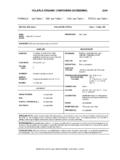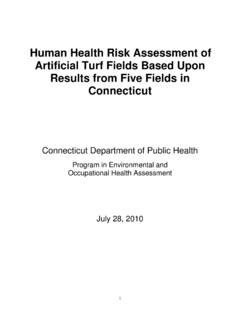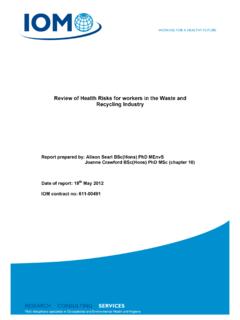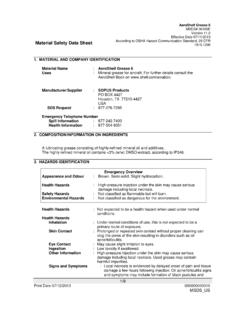Transcription of Consultation on monitoring of water-miscible …
1 health and safety executive Consultation on monitoring of water - miscible metalworking fluid (MWF) mists Prepared by the health and safety Laboratory for the health and safety executive 2015. RR1044. Research Report health and safety executive Consultation on monitoring of water - miscible metalworking fluid (MWF) mists Dr Helena Senior and Dr Gareth Evans health and safety Laboratory Harpur Hill Buxton Derbyshire SK17 9JN. The aim of this research was to examine metal working fluid (MWF) exposure limits and guidance set by other countries, summarise studies and investigations that examined water - miscible MWF mist as well as new techniques to monitor mist.
2 The following conclusions were drawn: n The majority of guidance levels or exposure limits for MWF mist relate to mineral oil and not water - miscible fluids. Certain recommended exposure limits (RELs) such as those set by NIOSH (USA) and INRS (France) relate to all MWFs. n European countries, with the exception of the UK, and the USA monitor all forms of MWF mist by capture onto filters (with or without subsequent chemical extraction steps), followed by gravimetric analysis or the use of infra-red spectroscopy. n Historically, average mist levels have not changed over time; the majority were below the previous UK guidance value of mg/m3 with a large proportion below the NIOSH REL of mg/m3.
3 This suggests that as ill health was reported at these low levels of mist, the exposure limits have no relevance to health risk. n A different approach to MWF mist monitoring may be required based on good practice. The question is whether the use of monitoring devices or internationally recognised methods (eg gravimetric analysis). might help to determine the effectiveness of this control strategy. This report and the work it describes were funded by the health and safety executive (HSE). Its contents, including any opinions and/or conclusions expressed, are those of the authors alone and do not necessarily reflect HSE policy.
4 HSE Books Crown copyright 2015. First published 2015. You may reuse this information (not including logos) free of charge in any format or medium, under the terms of the Open Government Licence. To view the licence visit , write to the Information Policy Team, The National Archives, Kew, London TW9 4DU, or email Some images and illustrations may not be owned by the Crown so cannot be reproduced without permission of the copyright owner. Enquiries should be sent to ii CONTENTS INTRODUCTION 3 Background 3 Overview of national MWF mist limits in Europe and USA 4 Aims 8 Objectives 8 METHODOLOGY 9 Interactions with Industry Experts 9 Summary of published evidence 11 Data extraction from relevant studies 11 Summary of data 11 RESULTS 13 Outcomes of Interaction with Industry Experts 13 Summary of published evidence 15 How comparable are studies that have monitored MWF mist?
5 16 What, in general terms, does the literature survey data demonstrate? 17 Current position on national exposure limits for MWFs 21 Potential role for particle counters 21 DISCUSSION 22 International and national exposure limits and guidance values for MWFs 22 Findings from summary of published studies on exposure to mist from water - miscible MWFs 23 Use of particle counters 25 SUMMARY AND KNOWLEDGE GAPS 28 Conclusions 28 Knowledge gaps 28 REFERENCES 30 APPENDICES 33 Appendix 1: UEIL Workshop Presentations 33 Appendix 2: HSL and HSE questions developed for industry Consultation 34 Appendix 3.
6 Data Extraction Form template 35 iii ABBREVIATIONS ACGIH American Council of Governmental Industrial Hygienists ACTS Advisory Committee on Toxic Substances ASTM American Standard for Testing & Materials BGIA Berufsgenossenschaftliches Institut f r Arbeitssicherheit COSHH Control of Substances Hazardous to health DECOS Dutch Expert Committee on Occupational safety EAA Extrinsic allergic alveolitis FIOH Finnish Institute of Occupational health GC-FID Gas chromatography with flame ionisation detector HBROEL health -based recommended occupational exposure limit HSE health & safety executive HSL health & safety Laboratory INRS Institut National de Recherche et de S curit.
7 ILMA Independent Lubricant Manufacturers Association 3. m Cubic metre mg Milligram ml Millilitre MAC Maximum workplace concentration MWF Metalworking fluid NIOSH National Institute for Occupational safety and health OEL Occupational exposure limit OEG Occupational exposure guidelines OES Occupational exposure standard OSHA Occupational safety and health Administration OTDS Organic toxic dust syndrome PEL Permissible exposure limit Registration, Evaluation, Authorisation and Restriction of REACH. Chemicals REL Recommended exposure limit SVHC Substance of very high concern STLE Society of Tribologists and Lubrication Engineers TDS Technical development survey TNO Netherlands Organisation for Applied Scientific Research TWA Time-weighted average UAW United Auto Workers UEIL Independent Union of the European Lubricants Industry UKLA UK Lubricants Association VOC Volatile organic compound WATCH Working Group on Action to Control Chemicals iv executive SUMMARY.
8 Outbreaks of ill health have occurred across the world in machining plants using water -based metalworking fluids (MWFs) despite apparent compliance with national exposure or guidance limits designed to protect worker health . An example of this is the large number of occupational asthma and extrinsic allergic alveolitis (EAA) cases observed at the Powertrain engine manufacturing plant in Birmingham, UK. Following this outbreak of ill health in 2005, the health and safety executive (HSE). withdrew all guidance limits relating to MWFs but this has left UK industry without a benchmark to demonstrate adequate control of mist.
9 Equally, there is uncertainty within the UK as to the continued relevance of the HSE-recommended boron marker method of monitoring water - miscible MWFs (MDHS. 95/2) as boron and its derivatives are being less widely included in MWF formulations following the possibility of imposed restrictions on its use in Europe. The aims of this project were to identify methods of monitoring water - miscible MWF mist and examine national guidance and exposure limits based on a Consultation with industry and academic experts. The relevance of set mist guidance limits reported in workplaces and their role in preventing ill health was examined by reviewing studies that had measured water - miscible MWF mist.
10 health and safety Laboratory (HSL) staff has interacted with UK industry by attending the quarterly meetings of the UK Lubricants Association (UKLA) MWF product stewardship group that discuss health and safety and regulatory issues associated with MWFs and their components. This led to invitations to present our research at a symposium on MWFs organised by the Independent Union of the European Lubricants Industry (UEIL) in Barcelona and to attend a workshop held at the UEIL. headquarters in Brussels to discuss air quality in engineering plants. The aim of the latter was to establish consensus as to whether a guidance limit for water - miscible MWF mist could be set for European industry.
















